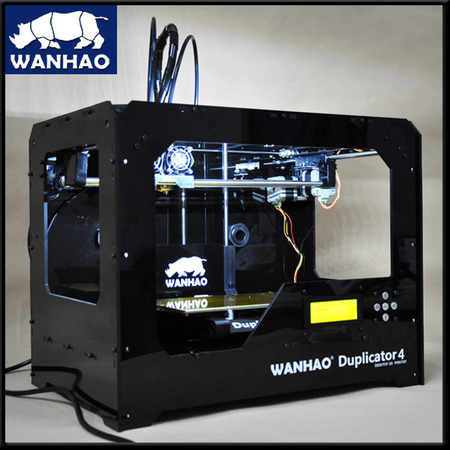When MakerBot opened some years ago it used open source approaches to developing its products. While they produced 3D printers, they also made available the plans to make them, open source-style. That changed with the introduction of their Replicator 2 model, much to the consternation of their open source followers.
Why did MakerBot make this move? In a word, competition. Their open source plans were (legally) taken by overseas competitors to produce less-expensive version of MakerBot’s products. A number of such competitors emerged, such as the one we’re looking at today: Wanhao 3D Printer.
The Jinhua, China based operation produces the Duplicator 4 that appears remarkably similar to MakerBot’s Replicator 1 product. Of course the two machines are different, as Wanhao has evolved the design with their own improvements, but clearly they got their start from MakerBot. Some replicated machines actually still work with MakerBot’s own software, MakerWare, but we’re not certain if the Duplicator does.
Sharing open source works if you’re not trying to profit from the venture, but MakerBot apparently was. Because of this phenomenon we’re pretty sure that MakerBot will never again offer open source designs, particularly after their acquisition by Stratasys. We also suspect new 3D printing startups may also question the strategy of open source, particularly if they have developed a radically new approach.
Via Wanaho



Here's another data point:
It's a complete myth that Makerbot went closed-source because they feared Chinese clones. It was a calculated business move to ensure more venture capital funding or a buy out. VCs don't give a shit about your open-source ideals. Makerbot don't give a shit about your maker movement.
And if the "R&D" that comes from the open-source community was worth anything more than jack shit, Makerbot would be out of business, overwhelmed by the tidal wave of "innovation."
Here's another data point:
It's a complete myth that Makerbot went closed-source because they feared Chinese clones. It was a calculated business move to ensure more venture capital funding or a buy out. VCs don't give a shit about your open-source ideals. Makerbot don't give a shit about your maker movement.
And if the "R&D" that comes from the open-source community was worth anything more than jack shit, Makerbot would be out of business, overwhelmed by the tidal wave of "innovation."
Just to offer one data point:
I was working at Makerbot at the time that they closed-sourced their printers, and I argued that the Chinese were going to copy us no matter what we did, and that the free R&D (and other benefits) that the community provided greatly out-weighed the (non-existent) protection that US law grants against being copied.
The machine pictured above resembles the Replicator 2, which was copied even though it was closed-source. (Note the black color, and the scoop on the left side of the front panel, which didn't exist on the Rep1.)
I take this to be pretty good evidence that it doesn't matter whether or not you open-source your designs, you're going to be copied (and it's legal most of the time, and impossible to prosecute the rest of the time).
If there are any decision makers from any other 3D printing startups reading this: open source your designs, and take the free R&D.
It's just good business.
Just to offer one data point:
I was working at Makerbot at the time that they closed-sourced their printers, and I argued that the Chinese were going to copy us no matter what we did, and that the free R&D (and other benefits) that the community provided greatly out-weighed the (non-existent) protection that US law grants against being copied.
The machine pictured above resembles the Replicator 2, which was copied even though it was closed-source. (Note the black color, and the scoop on the left side of the front panel, which didn't exist on the Rep1.)
I take this to be pretty good evidence that it doesn't matter whether or not you open-source your designs, you're going to be copied (and it's legal most of the time, and impossible to prosecute the rest of the time).
If there are any decision makers from any other 3D printing startups reading this: open source your designs, and take the free R&D.
It's just good business.